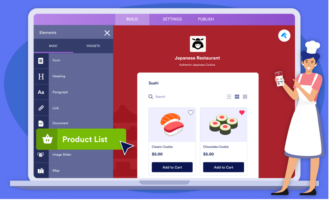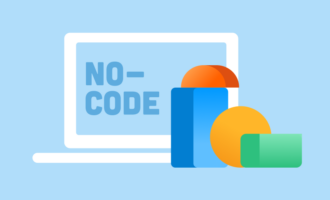Top no-code tools
If your business isn’t using no-code tools yet, you could be missing out on countless opportunities to streamline your workflows, save time, and get the results that your business needs to thrive.
No-code tools don’t require programming. Instead, they provide an easy-to-use platform that can help you create — well, just about anything.
No-code tools have become so popular that they’re available for all sorts of different business processes. You can use these tools to create mobile apps and websites, manage projects and teams, automate workflows and processes, and more.
Pro Tip
Expertly manage your data in a spreadsheet, calendar, or easy-to-read cards with Jotform Tables.
Top no-code tools of 2025
Whether you want to create an app, design a professional website, or automate your workflows, these top no-code tools could fit the bill for your business needs. Keep reading to review the tools, which we’ve organized into different categories.
Best no-code tools for information collection
1. Jotform
Capterra user rating: 4.7 (1,850-plus reviews)
G2 user rating: 4.7 (3,000-plus reviews)
Who uses Jotform? Businesses, nonprofits, and professionals in education and healthcare that regularly use online forms for data collection
Jotform simplifies the process of creating forms and collecting the information you get when people fill them out.
With Jotform, you don’t have to worry about not having coding experience, thanks to the large libraries of form templates and table templates available to help you create custom forms and databases for your business. And Jotform’s drag-and-drop editor means there’s no need to code anything.
Jotform enables you to easily create forms to collect applications and leads, collect timesheet information from staff, survey your social media followers, collect job applications, manage memberships, gather staff onboarding information, sell products and services, and so much more. Plus, the information you gather is easily accessible and sortable through Jotform Tables.
And the no-code features don’t stop there. You can also create apps thanks to Jotform’s no-code app builder, Jotform Apps, and with Jotform Approvals, you can easily set up approval flows — and neither one requires any coding.
Key features
- Drag-and-drop form builder
- Conditional logic
- Payment integrations
- Data collection and management
- Email notifications and auto-responders
Pros
- It’s a very beginner-friendly platform with intuitive functionality that doesn’t require any coding experience.
- It offers a diverse selection of question types beyond regular text fields, so you can create comprehensive forms for various purposes.
- The free plan offers a substantial number of form submissions, form fields, and storage space, making it suitable for basic needs.
Cons
- It may not provide the same level of design control as graphic design software for crafting highly unique and visually complex forms.
- Building intricate branching logic with conditional rules can become challenging for users new to Jotform or unfamiliar with conditional logic concepts.
- It may not be ideal for managing extremely large datasets collected through forms.
Pricing: Jotform is available in a free plan as well as four tiers of paid plans starting at $34 per month.
User review:
“It is easy to use, and the base model is free. The customization is wonderful, with the ability to create beautiful applications.”(Source: Capterra)
2. Airtable
Capterra user rating: 4.7 (1,900-plus reviews)
G2 user rating: 4.6 (2,200-plus reviews)
Who uses Airtable? Organizations that want to build custom databases, spreadsheets, and apps to manage in-house workflows
Airtable, a tool that combines the features of a spreadsheet and a database, makes project management easy and intuitive. Airtable is streamlined and simple to use, saving you from having to build a database. It integrates with many platforms and lets you easily assign tasks and deadlines, track projects, and monitor budgets with its visual user interface.
Key features
- Prebuilt building blocks
- Formula fields
- Milestone tracking
- Interface designer
- Multiple data views (list, timeline, Gantt, etc.)
Pros
- Airtable lets teams design their workspaces exactly as they need them. From the base structure to views and automations, it offers a high degree of customization.
- The user interface is intuitive and very user-friendly. That plus its drag-and-drop functionality make it accessible for beginners.
- Multiple users can access and edit the same base — a collection of data — simultaneously, enabling collaborative app building and project management.
Cons
- Managing intricate relationships and complex formulas within large Airtable bases can become challenging.
- Mastering automations and formulas may require additional learning.
- Once your data is in Airtable, exporting it in a fully usable format for other platforms can be cumbersome.
Pricing: Airtable offers a free plan in addition to a Team plan that costs $20 per user, per month (billed annually) and a Business plan for $45 per user per month.
User review:
“Airtable is brilliant for all project management needs it’s useful because you can create basis for all of your work and then follow things through to completion.” (Source: Capterra)
Best no-code tools for communication
3. Mailchimp
Capterra user rating: 4.5 (16,800-plus reviews)
G2 user rating: 4.3 (12,400-plus reviews)
Who uses Mailchimp? Businesses of all sizes in every industry that want an easy way to send email communications to prospective customers
Mailchimp features design tools and templates that are easy to use, simplifying the process of designing emails and websites. Thanks to more than 250 app integrations, you can enhance the way that Mailchimp works with your business.
The drag-and-drop builder makes it easy to create a professional-looking email that will get you results. And if you need some assistance, Mailchimp offers editors to help you build out landing pages, digital ads, social media posts, postcards, and more, making it a must-have for marketers.
Key features
- Email builder
- Campaign manager
- A/B testing
- Automation tools
- Generative AI for copy creation
Pros
- You can design automated email sequences based on user behavior or triggers.
- You can track the performance of your email campaigns with detailed analytics such as open and click-through rates.
- You can create landing pages directly within Mailchimp, eliminating the need for separate tools.
Cons
- Mailchimp’s design options may be limiting for experienced users seeking complete creative control over email design.
- The free plan restricts popular features like automation, A/B testing, and list segmentation, along with customer support.
- Mailchimp’s price increases are based on the number of subscribers on your list, so it can become expensive for organizations with large audiences.
Pricing: The basic plan is free. There are three paid tiers that go up to $350 per month. Prices scale based on the number of contacts you have.
User review:
“Our audience has loved our transition to Mailchimp (especially better formatted email on mobile) and our email senders have loved the transition too.” (Source: Capterra)
4. Landbot
Capterra user rating: 4.6 (60-plus reviews)
G2 user rating: 4.7 (300-plus reviews)
Who uses Landbot? Businesses and individuals who want to automate customer interactions, capture leads, or enhance website engagement with chatbots
Landbot enables users to create conversational AI chatbots without writing code. Using a drag-and-drop interface, you can design conversation flows, integrate various services, and personalize user experiences.
Key features
- Drag-and-drop conversation builder
- WhatsApp automation
- AI appointment assistant
- Conditional logic and branching
- Multi-language support
Pros
- You can enable live chat functionality so human agents can take over a conversation when needed.
- Chatbots can converse in multiple languages to reach a wider audience.
- You can connect your chatbot with numerous services to expand its usefulness.
Cons
- Landbot may not be ideal for managing massive datasets from highly chat-intensive applications.
- Multiple users cite lackluster customer service.
- Many users find the platform to be expensive.
Pricing: Landbot offers an extremely feature-limited free plan. Paid plans start at $36 per month (billed annually).
User review
“My overall experience is more than positive! The Landbot works well, in a reliable, responsive, pleasant and well structured interface.” (Source: Capterra)
Best no-code tools for app building
5. Bubble
Capterra user rating: 4.6 (320-plus reviews)
G2 user rating: 4.4 (150-plus reviews)
Who uses Bubble? Teams of all sizes across various industries that want a simple way to build web applications
Bubble simplifies the process of building web apps. The fully customizable application development platform means you can build and design apps without HTML or CSS. Templates and plug-ins are available on the marketplace to help you bring your app to life, and the drag-and-drop platform is user-friendly and intuitive.
Key features
- Drag-and-drop interface
- Customizable database design
- Frontend and backend development
- Reusable elements and workflows
- Version control
Pros
- It offers a high degree of customization for both design and logic.
- The visual interface and prebuilt elements allow for quick prototyping and development cycles.
- It can handle complex applications with large user bases and intricate data structures.
Cons
- Building complex applications with Bubble requires a more advanced understanding of its logic and functionalities.
- Performance limitations may arise for highly dynamic applications with a large user base.
- Its design capabilities may not offer the same level of pixel-perfect control as traditional web development with code.
Pricing: Bubble is available in a free plan. Pricing plans start at $29/month (billed annually).
User review
“Bubble is a wonderful and very complete webapp building service without being a coder. You can build virtually anything with it and the many plugins that allow you to diversify your app.” (Source: Capterra)
6. Stacker
Capterra user rating: 4.7 (40-plus reviews)
G2 user rating: 4.5 (10 reviews)
Who uses Stacker? Organizations that want to build apps to power their business
Stacker is a no-code tool that bridges the gap between spreadsheets and full-fledged applications, allowing business users to create internal tools, customer portals, and data visualization dashboards without needing to understand coding. Users can leverage their existing data in Google Sheets or Airtable.
Key features
- Drag-and-drop app builder
- Customizable user interface
- Data filtering and sorting
- Permissions and user roles
- Data automation
Pros
- You can use existing spreadsheets to easily migrate data.
- The visual interface makes the platform accessible for non-technical users.
- You can control user access and data visibility to maintain higher security.
Cons
- Customization options may be limited compared to dedicated app development tools.
- It may not be ideal for managing very large datasets within complex spreadsheets.
- Migrating an app built in Stacker to another platform can be challenging due to its reliance on Stacker’s infrastructure.
Pricing: Stacker offers three plans. There’s no free plan, but it does offer a 30-day trial with all features included. Contact Stacker for pricing details.
User review
“Its two-way connection with Airtable is great. We have had a great experience building no-code web-apps using Stacker. I recommend it very much and have been using it several years now.” (Source: G2)
7. Softr
Capterra user rating: 4.7 (50-plus reviews)
G2 user rating: 4.8 (300-plus reviews)
Who uses Softr? Another option for teams of all types — operations, customer support, marketing, HR, and more — that want to build apps that make work easier
Softr enables you to transform your spreadsheet data into functional web applications. Without coding, you can design user interfaces, connect data tables, and create dynamic apps. Softr is ideal for businesses or individuals who want to build internal tools, client portals, or public-facing web applications based on their existing data in Google Sheets, Airtable, HubSpot, and SmartSuite.
Key features
- Drag-and-drop interface
- Data binding
- Interactive components
- User roles and permissions
- SEO optimization
Pros
- It makes sharing and collaborating on data with internal teams easy.
- The platform is simple to learn, even for beginners with no coding experience.
- It has prebuilt components that help accelerate the app development process.
Cons
- Building intricate functionality with relational data connections may have a steep learning curve.
- It can get pricey for apps with high traffic or those that require significant storage space.
- Its prebuilt blocks make customizing your app more challenging.
Pricing: Softr offers a free plan with its branding and a few limitations. Paid plans start at $49 per month (billed annually).
User review
“One of the most straightforward no-code solutions I have found that is tidy, professional, and fits my needs out of the many I have tested.” (Source: Capterra)
8. Glide
Capterra user rating: N/A
G2 user rating: 4.7 (500-plus reviews)
Who uses Glide? Enterprises, field teams, and agencies
Glide is a no-code tool that lets you use your existing databases to build mobile apps, web apps, and progressive web apps (PWAs) for a variety of use cases such as field operations, event management, customer and employee portals, and inventory management. The platform works with Google Sheets, Excel, Airtable, BigQuery, SQL databases like PostgreSQL and MySQL, and more.
Key features
- Automatic app layout generation based on database
- User management
- Real-time data updates
- Data binding
- Drag-and-drop interface
Pros
- Non-technical users can easily grasp it.
- Updates in your spreadsheet or other database instantly reflect in the connected app.
- It has a large collection of educational resources to help users acclimate to the platform and address issues.
Cons
- Building apps with advanced features may require additional learning.
- Offline access to data or functionality may be limited.
- Limited scalability when dealing with larger, more complex applications.
Pricing: Glide’s plans start at $99 per month (billed annually). It also offers a free 30-day trial on the Business plan.
User review
“Over my two years of use, I’ve found that Glide empowers me to swiftly transform ideas into functional applications, enabling efficient iteration and informed decision-making.” (Source: G2)
9. Bravo Studio
Capterra user rating: 5.0 (1 review)
G2 user rating: 4.8 (5 reviews)
Who uses Bravo Studio? Designers, freelancers, entrepreneurs, founders, and product managers who want to build attractive mobile apps
Bravo is a no-code mobile app-building platform that enables users to turn their designs created in Figma — a collaborative interface design tool — into native iOS and Android apps. Users can connect their Figma project and define interactions, add functionality, create prototypes, and publish their apps to the app stores.
Key features
- Figma design integration
- Native mobile app development
- Interactive prototyping
- Testing across devices
- Conditional logic
Pros
- Figma users can save time and resources in converting their prototypes into functional apps.
- You can build apps that adapt and respond to user choices or data conditions.
- You can publish your completed app to major app stores without additional development steps.
Cons
- You can only create native mobile apps in Bravo — no web apps or PWAs.
- It requires knowledge of and experience using Figma or Adobe XD for design prototyping.
- It doesn’t export the source code, so you won’t be able to add custom functionality or integrate closed source frameworks.
Pricing: Bravo offers a free plan with a few limitations. Paid plans start at $18 per month (billed annually).
User review
“Apart from letting you create apps without the need of code, I think it’s also a great tool to quickly prototype and validate MVP and design ideas [with] a real hands-on experience. It has lots of potential.” (Source: Capterra)
10. Jotform Apps
Capterra user rating: N/A
G2 user rating: 4.7 (200-plus reviews)
Who uses Jotform Apps? Businesses, nonprofits, and professionals in education and healthcare who want a simple way to convert forms into apps
It’s Jotform again! Well, Jotform Apps to be exact — one of the many powerful tools in the Jotform suite. While Jotform is focused on building forms, Jotform Apps is focused on building apps. This free, no-code app builder lets you add forms, widgets, products, branding, and more. Jotform Apps is ideal for businesses and individuals who want to convert their forms into user-friendly mobile apps, streamlining data collection and user interaction.
Key features
- Jotform form integration
- Drag-and-drop app builder
- Mobile payment integration
- Appointment scheduling
- Conditional logic
Pros
- It connects seamlessly with Jotform forms for streamlined data management.
- You can enable limited access to certain functionality even without an internet connection.
- You can track app performance with analytics to gain key insights on user behavior.
Cons
- Customization options may be limited compared to professional app development tools.
- It relies on forms built in Jotform to function.
- Certain features such as payment and appointment integrations are only available on paid plans.
Pricing: Jotform Apps is available in a free plan as well as four tiers of paid plans starting at $34 per month.
User review
“A few months ago, I encountered Jotform Apps, and I was astounded by its capabilities. It presents itself as a pure no-code platform, complete with comprehensive drag-and-drop functionalities that render app creation a piece of cake. It’s akin to playing a game, and the experience is incredibly enjoyable.” (Source: G2)
11. Adalo
Capterra user rating: 3.5 (20-plus reviews)
G2 user rating: 4.6 (5 reviews)
Who uses Adalo? Small to medium-sized businesses that want to launch an app quickly
Adalo is a no-code tool that allows users to build mobile and web apps visually. People typically use the platform to create prototypes, MVPs (minimum viable products), or even full-fledged applications for various purposes such as collecting data, managing tasks, and showcasing products.
By dragging and dropping prebuilt elements and using a spreadsheet-like interface to define app logic, even those with no coding experience can use Adalo to create functional and interactive applications.
Key features
- Drag-and-drop design
- Database integration
- Visual database builder
- Customizable user authentication
- Responsive design
Pros
- The visual interface allows anyone to build apps without coding knowledge.
- It offers integrated web app development, so you can create web apps alongside mobile apps for a unified user experience across platforms.
- You can define custom logic and workflows to tailor your app’s behavior to specific needs.
Cons
- You may need to integrate Adalo with external database solutions for extremely large datasets or complex data management needs.
- As your app grows in complexity and user base, Adalo’s paid plans can become expensive for high-traffic or data-intensive applications.
- Once you’ve built your app within Adalo, migrating it to another platform can be challenging due to its proprietary nature.
Pricing: Adalo offers a free plan with limited app actions and no allowance for publishing an app. Paid plans start at $36 per month (billed annually).
User review
“Adalo is a great LowCode/NoCode Builder. It is very easy to learn…” (Source: G2)
12. Thunkable
Capterra user rating: 4.4 (3 reviews)
G2 user rating: 4.4 (30-plus reviews)
Who uses Thunkable? Individuals and startup teams that want to create apps for sale in the iOS and Android app stores
Thunkable is a no-code tool that lets you build custom mobile apps using a simple drag-and-drop interface. You can quickly design layouts, add various functions, and integrate features such as geolocation and user authentication without having developer expertise.
Key features
- Native app development
- User management
- Location services
- Conditional logic
- Database integration
Pros
- It’s easy to pick up for non-technical users, especially with its drag-and-drop interface.
- You can build apps that use location services, cameras, and other device functionality.
- You can publish directly to the App Store and Google Play store.
Cons
- There’s no offline editing for app development — you must have an internet connection.
- Essential features are paywalled, so the free plan is quite limited.
- You have limited customization options compared to more technical platforms.
Pricing: Thunkable offers a limited free plan. Paid plans start at $13 per month (billed annually).
User review
“Thunkable is a highly beginner-friendly platform that truly makes building an app accessible for anyone! I could even see this being used as a first step to teaching coding concepts like loops and control flow without having to deal with all the complications of coding syntax.” (Source: G2)
Best no-code tools for website building
13. Carrd
Capterra user rating: 4.7 (20-plus reviews)
G2 user rating: 4.5 (30-plus reviews)
Who uses Carrd? Small businesses, freelancers, and startups looking to build an extremely simple site
With Carrd, creating simple, one-page websites is easy and fast. Completely free to use, Carrd features templates for your website, or you can create one from scratch. All sites are responsive, so they’ll look just right on a phone, tablet, or other device. Carrd is an ideal solution for building landing pages, personal profiles, and other sites.
Key features
- Responsive design
- Drag-and-drop editing
- Built-in forms
- Customizable templates
- HTML input (for greater customization)
Pros
- It allows you to create quick, straightforward websites without the complexities of traditional website builders.
- Single-page websites built with Carrd tend to load faster, which can improve the user experience.
- The free plan is suitable for simple websites like landing pages, portfolios, or “coming soon” pages.
Cons
- It has limited functionality compared to similar no-code tools, so it’s not suitable for creating complex websites with multiple pages, user accounts, or e-commerce capabilities.
- It may not be as powerful as dedicated website builders for optimizing your site for search engines.
- The free plan limits you to Carrd branding and basic analytics.
Pricing: Pricing plans start at $9 per year, and there are three different plans to choose from.
User review
“Carrd is easy to use, has great templates, perfect integration with all the necessary software, I don’t need anything else from a landing page builder.” (Source: Capterra)
14. Webflow
Capterra user rating: 4.6 (230-plus reviews)
G2 user rating: 4.4 (550-plus reviews)
Who uses Webflow? Small businesses, freelancers, and e-commerce businesses that want a high degree of control over their site’s look and feel
With Webflow, you can build websites and custom databases without any coding. Webflow makes it easy to integrate animations, parallax scrolling, and other sophisticated elements while building in HTML5, CSS, and JavaScript. The platform is free to use until you’re ready to launch your site. The designer is completely visual, and the Webflow hosting network will scale with your site as your business grows.
Recently, the platform added e-commerce capability, so you can also build online stores directly within Webflow.
Key features
- Visual website builder
- Content management system (CMS)
- Customizable interactions and animations
- Responsive and mobile-first design
- Clean code generation
Pros
- It offers a high degree of design freedom, allowing you to customize every aspect of your website.
- The generated code is well-structured and can be further customized with development tools if needed, offering flexibility for future modifications.
- The built-in CMS allows for easy management of website content, making it ideal for websites requiring frequent updates or user-generated content.
Cons
- Mastering Webflow’s functionality for complex layouts and animations may require dedicated learning and practice.
- It offers a smaller range of third-party plug-ins for extending functionality compared to some website builders. Custom development may be needed for specific needs.
- Its pricing plans are based on website traffic and features required. For simpler websites with low traffic, other builders may be more cost-effective options.
Pricing: Webflow is available in a free plan. Pricing plans start at $14 per month (annual billing).
User review
“I like Webflow because it is the freedom of design translated to the web. You don’t have to be a programmer to create a great website.” (Source: Capterra)
15. Shopify
Capterra user rating: 4.6 (6,300-plus reviews)
G2 user rating: 4.4 (4,500-plus reviews)
Who uses Shopify? Small businesses up to enterprises that want to build an online e-commerce store
Shopify is a powerful e-commerce website builder that can help you quickly get your store online and running. Store themes mean you don’t have to design from scratch, while Shopify tools like email and social media builders help you to make a professional impression from the start.
Shopify even offers a business name generator to help you with your branding. More than 6,000 apps integrate with Shopify for enhanced site functionality.
Key features
- Drag-and-drop storefront builder
- Product management and inventory control
- Built-in payment processing
- Shipping management
- Sales and marketing analytics
Pros
- It’s designed to be user-friendly, even for beginners with no prior e-commerce experience.
- It offers a variety of integrated payment gateways, allowing you to accept credit cards, debit cards, and alternative payment methods for a global audience.
- It offers essential marketing and sales functionalities within the platform, eliminating the need for separate tools for basic email marketing, discounts, and abandoned cart recovery.
Cons
- Shopify charges transaction fees on each sale made through their platform, which can quickly add up for high-volume businesses.
- The free trial and lower-tier plans offer limited customization options for your store’s design, and they limit bandwidth and storage.
- It may offer less flexibility for custom code compared to self-hosted e-commerce platforms.
Pricing: Pricing starts at $29 per month (annual billing), and they offer a free three-day trial.
User review:
“I love Shopify because it allowed me to build my website and sell products with ease. I love that there are apps you can add that help you customize to your needs.” (Source: Capterra)
16. Squarespace
Capterra user rating: 4.6 (2,900-plus reviews)
G2 user rating: 4.4 (1,000-plus reviews)
Who uses Squarespace? Entrepreneurs, photographers, restaurants, musicians, businesses, fashion designers, and more who are looking for a simple website builder with e-commerce functionality
Squarespace enables you to design websites without writing code. Its drag-and-drop interface allows you to design layouts, add content, and customize functionality. It offers not only website creation, but also domain registration, hosting, and even basic SEO tools.
Key features
- Drag-and-drop website builder
- Mobile-responsive design
- E-commerce store
- Content management system
- SEO and analytics
Pros
- It’s a very beginner-friendly platform for non-technical users and non-designers.
- It offers numerous website templates across a number of categories.
- It includes a variety of complementary services such as hosting and domain registration to make it easy to create a website without needing multiple solutions.
Cons
- Its template-centered approach and restrictions on code access limit your website customization options.
- Significant design changes to the overall layout may be challenging after choosing a template.
- Squarespace might not be ideal for websites that will experience extremely high traffic volumes.
Pricing: Squarespace offers a free, 14-day trial. Paid plans start at $16 per month (billed annually).
User review
“Squarespace is the most intuitive, simple and easy to use web builder I’ve ever used. I recommend it to all my clients who aren’t confident in their website management skills.” (Source: Capterra)
17. Memberstack
Capterra user rating: 4.0 (1 review)
G2 user rating: 4.7 (90-plus reviews)
Who uses Memberstack? Developers, freelancers, and small businesses that want to offer members-only content on their website
Memberstack gives you the tools to create membership websites without writing code. You can integrate it with Webflow and Stripe to manage member signup, login, content access, and payment processing. Essentially, it takes the hassle out of building in these basic elements — which are necessary but dull — so developers can focus on core project pieces.
Key features
- Authentication
- Payments
- User management
- Content gating
- If-then logic for member plan management
Pros
- Memberstack is SOC-2 Type 1 certified, which is a positive nod to its security.
- You can restrict access to specific website content based on membership tiers.
- You can create and manage coupon codes or promotional offers for memberships.
Cons
- Its free templates don’t include support, tutorials, or automations.
- Building intricate membership structures with advanced rules may present a learning curve.
- Much of its functionality relies on integrations with third-party services such as website builders and payment processors.
Pricing: Memberstack offers a free-to-try option where you can set up a fully functional test site with no time limitations, but accepting real members requires payment. Paid plans start at $25 per month (billed annually).
User review
“Memberstack is incredibly user-friendly. The first time I tried it, I effortlessly nailed it. I appreciate the extensive resources provided, eliminating the need to start from scratch.” (Source: G2)
18. Zapier
Capterra user rating: 4.7 (2,800-plus reviews)
G2 user rating: 4.5 (1,200-plus reviews)
Who uses Zapier? Business owners, marketers, IT personnel, operations staff, and other professionals at small and mid-sized businesses that use a lot of different apps as part of their workflows
Zapier is a workflow automation tool that takes care of time-consuming and repetitive tasks so you and your staff can focus on the work that really needs your attention. Zapier integrates with your web apps to trigger certain actions. For example, when you get a new email in Gmail, Zapier can copy the attachment into your Dropbox folder and send you an alert in Slack. The editor is do-it-yourself friendly.
Key features
- Prebuilt and customizable Zaps (automations)
- Scheduled and multi-step Zaps
- Zap history and monitoring
- Conditional logic
- Visual editor
Pros
- It has thousands of premade Zaps connecting various apps and services, which saves time in building workflows.
- You can connect apps that don’t natively integrate using Zapier.
- Prebuilt Zaps make it easy to get started using the platform since you can find existing automations for many common use cases.
Cons
- The free plan restricts the number of Zaps you can create and monthly tasks it can handle. Upgrading to paid plans is necessary for extensive use.
- Building intricate Zaps with filters, conditions, and multi-steps may require fairly significant learning and understanding of Zapier’s logic.
- Zapier relies on the functionality offered by the apps to which you connect. Limitations in an app’s API may restrict what Zaps can achieve.
Pricing: Zapier offers five different pricing tiers, ranging from free to $69 per month with annual billing.
User review:
“The support from Zapier is amazing and is so comprehensive, and this was immeasurable in the initial stages of its inauguration.” (Source: Capterra)
19. Make
Capterra user rating: 4.8 (300-plus reviews)
G2 user rating: 4.7 (215-plus reviews)
Who uses Make? Tech-savvy entrepreneurs, small to midsize companies, and enterprises, along with system administrators, IT engineers, and geeks who want to automate more complex workflows
Make (formerly Integromat) empowers you to automate repetitive tasks and connect various web services without writing code. Using a visual interface, you can design workflows (called “scenarios”) that trigger actions across different apps and platforms. Make is ideal for businesses and individuals who want to automate manual processes, streamline data flow, and integrate various tools within their workflow.
Key features
- Visual workflow builder
- Custom code modules
- Conditional logic and branching
- Error handling and scheduling
- Webhooks and API access
Pros
- It can connect with numerous popular web services through its prebuilt integrations.
- You can clean, format, and transform data as it moves between applications within your workflows.
- You can work together with other team members in building and managing your workflows with collaboration features.
Cons
- Complicated workflows may be hard to debug.
- Many users say that the way Make counts workflows is confusing (which is important given its free plan’s workflow limitations).
- Based on user reviews, support response time can be slow.
Pricing: Make offers a free plan that limits you to two workflows. Paid plans start at $9 per month (billed annually).
User review
“I love that anyone without a strong tech background can use Make and set up their own integrations. There is a huge Make community and lots of resources available to figure out all the possibilities and get support for any anomalies. It’s quick to pick up and reasonably priced.” (Source: G2)
20. IFTTT
Capterra user rating: 4.6 (200-plus reviews)
G2 user rating: 4.6 (100-plus reviews)
Who uses IFTTT? Individuals with smart homes who want to connect their various devices and businesses looking to automate social media and productivity workflows
IFTTT, which stands for If This Then That, is an automation tool for business and home that lets you integrate various web services and devices without coding. By setting up “applets” (mini automations), you define triggers in one app (the “If” part) that automatically activate actions in another app (the “Then” part). You can customize and control your integrations with filter code, queries, and multiple actions.
Key features
- Prebuilt applets
- Custom applet creation
- Conditional logic
- Scheduled triggers
- Notifications and activity log
Pros
- The platform has a user-friendly interface and prebuilt elements that make it easy for beginners to pick up.
- It offers a wide range of integrations to connect.
- Many users cite its usefulness for home automation.
Cons
- Some users report that the platform is unreliable, with inconsistent triggers and alerts in their workflows.
- You have limited control over the prebuilt applets.
- Scheduling functionality may be limited compared to more advanced automation tools.
Pricing: IFTTT offers a free plan that limits you to two applets. Paid plans start at $12.50 per month (billed annually).
User review
“The user interface and the app are easy to understand and use. Integrating services is as easy as signing in with the click of a button. The applets you use are well-organized and the suggested applets are often very useful once IFTTT figures out more or less what you’re looking for on its platform.” (Source: G2)
Implementing no-code tools
Writing code, dealing with overwhelming website backend designs, and reading through tutorials is a waste of time for both you and your staff. And when you’re running a small business, you might not have the budget for programmers.
These low-code and no-code solutions are ideal for businesses of all sizes, and they empower you to tackle app development, website design, workflow automation, and so much more. With so many tools available for many different tasks, you may notice that you’re saving time and improving your business operations as you implement them.

























































































































Send Comment: